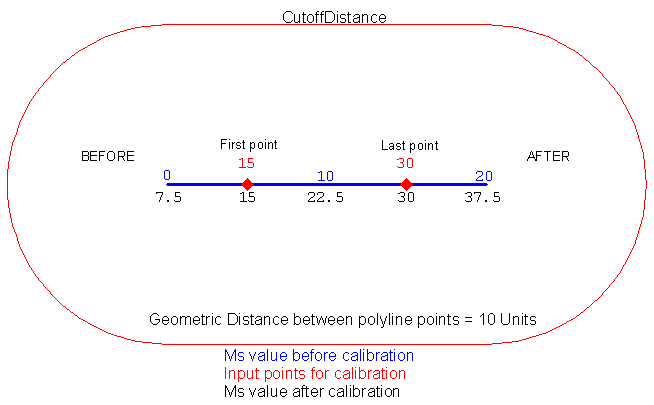 |
This document is archived and information here might be outdated. Recommended version. |
 |
This document is archived and information here might be outdated. Recommended version. |
Calibrates Ms of existing vertices using new Ms from the input points and the shortest path distances along the polyline between those points. The update method is given as a combination of esriGeometryUpdateMEnum values.
[Visual Basic .NET] Public Function CalibrateByDistance ( _ ByVal Points As IEnumVertex, _ ByVal updateHow As Integer, _ ByVal ignoreGaps As Boolean, _ ByVal cutoffDistance As Double _ ) As IEnumSplitPoint
[C#] public IEnumSplitPoint CalibrateByDistance ( IEnumVertex Points, int updateHow, bool ignoreGaps, double cutoffDistance );
[C++]
HRESULT CalibrateByDistance(
IEnumVertex* Points,
long updateHow,
VARIANT_BOOL ignoreGaps,
double cutoffDistance
);
[C++]
Parameters Points
Points is a parameter of type IEnumVertex* updateHow
updateHow is a parameter of type long ignoreGaps
ignoreGaps is a parameter of type bool cutoffDistance
cutoffDistance is a parameter of type double
The updateHow argument is given as a combination of esriGeometryUpdateMEnum values. When combining multiple values, the bitwise Or operator should always be used. This assures an error-free combination of the values (as long as the attempted combination is valid). Do not use the addition operator (+) to combine the values as unexpected results may occur.
For example, to interpolate between the input points and to extrapolate before and after the input points, you would use 7, which equates to: esriGeometryInterpolate OR esriGeometryExtrapolateBefore OR esriGeometryExtrapolateAfter. A value of 0 will only split the input polyline and assign the Ms value to the new created vertex. If an input point has the same X (or projected to the same X) as an existing vertex the Ms value of the existing vertex will be updated.
Note : The "After" and "Before" for the updateHow parameter is define by the order of the points in the multipoints. Ex : If the points are define from left to right the "Before" will be at the left of the first point and the "After" will be at the right of the last point.
The cutoffDistance parameter is an input Double that represents the distance from the polyline from where points are not considered anymore as being valid calibration points.
The following picture demonstrates graphically the method behavior. A updateHow paramater of 7 has been used.

esriGeometryInterpolate=0001 (1)
esriGeometryExtrapolateBefore=0010 (2)
esriGeometryExtrapolateAfter=0100 (4)
0001
0010
0100
----
0111
[C#]
public void CalibratePolyLineByDistance(IPolyline polyline, IMultipoint multipoint, int updateHow, bool ignoreGaps, double cutOffDistance)
{
/*
This function will use IMSegmentation2.CalibrateByDistance. This method
calibrates the Ms using geometric distance. If you want to calibrate using
some existing M values, then use IMSegmentation2.CalibrateByMs
updateHow is a bitwise combination of these three values:
esriGeometryInterpolate=1
esriGeometryExtrapolateBefore=2
esriGeometryExtrapolateAfter=4
Note that CalibrateByDistance does not require that MultiPoint's points
fall on top of the PolyLine. You might consider adding some logic to make
sure that the points fall on top of (e.g. ITopologicalOperator.Intersect)
or are within a tolerance (e.g. IProximityOperator.ReturnDistance)
If you pass in a PolyLine that is from a data source of unknown quality,
you may consider calling IGeometryCollection.GeometriesChanged before
you call IPolyLine.SimplifyNetwork below. This is because SimplifyNetwork
will not do anything if the geometry is assumed to be simple. Calling
GeometriesChanged tells the geometry that it is not simple.
*/
//This operation must be performed on a simple geometry
polyline.SimplifyNetwork();
//The MultiPoint's points should have Ms
IMAware mAware=multipoint as IMAware;
if(!mAware.MAware)
{
return;
}
//The PolyLine should be M Aware as well.
mAware=polyline as IMAware;
if(!mAware.MAware)
{
return;
}
IMSegmentation2 mSegmentation=polyline as IMSegmentation2;
IPointCollection pointCollection=multipoint as IPointCollection;
IEnumVertex enumVertex=pointCollection.EnumVertices;
IEnumSplitPoint enumSplitPoint=mSegmentation.CalibrateByDistance(enumVertex, updateHow, ignoreGaps, cutOffDistance);
//Note that we do nothing with enumSplitPoint. IEnumSplitPoint specializes
//IEnumVertex and gives additional information about the locations in a
//PolyLine where it was split by a set of input points
}
Public Sub CalibratePolyLineByDistance(ByVal pPl As ESRI.ArcGIS.Geometry.IPolyline, ByVal pMP As ESRI.ArcGIS.Geometry.IMultipoint, _
ByVal updateHow As Long, ByVal ignoreGaps As Boolean, ByVal dCOffDist As Double)
'+++ This function will use IMSegmentation2::CalibrateByDistance. This function
'+++ calibrates the Ms using geometric distance. If you want to calibrate using
'+++ some existing M values, then use IMSegmentation2::CalibrateByMs
'+++ updateHow is a bitwise combination of these three values:
'+++ esriGeometryInterpolate=1
'+++ esriGeometryExtrapolateBefore=2
'+++ esriGeometryExtrapolateAfter=4
'+++ Note that CalibrateByDistance does not require that MultiPoint's points
'+++ fall on top of the PolyLine. You might consider adding some logic to make
'+++ sure that the points fall on top of (e.g. ITopologicalOperator::Intersect)
'+++ or are within a tolerance (e.g. IProximityOperator::ReturnDistance)
'+++ If you pass in a PolyLine that is from a data source of unknown quality,
'+++ you may consider calling IGeometryCollection::GeometriesChanged before
'+++ you call IPolyLine::SimplifyNetwork below. This is because SimplifyNetwork
'+++ will not do anything if the geometry is assumed to be simple. Calling
'+++ GeometriesChanged tells the geometry that it is not simple.
'+++ This operation must be performed on a simple geometry
pPl.SimplifyNetwork()
Dim pMA As ESRI.ArcGIS.Geometry.IMAware
Dim pMSeg As ESRI.ArcGIS.Geometry.IMSegmentation2
'+++ The MultiPoint's points should have Ms
pMA=pMP
If Not pMA.MAware Then _
Err.Raise(vbObjectError + 11282000, "CalibratePolyLineByDistance", "MultiPoint Not M Aware")
'+++ The PolyLine should be M Aware as well.
pMA=Nothing
pMA=pPl
If Not pMA.MAware Then
Err.Raise(vbObjectError + 11282000, "CalibratePolyLineByDistance", "PolyLine Not M Aware")
Else
Dim pPC As ESRI.ArcGIS.Geometry.IPointCollection
Dim pEnumV As ESRI.ArcGIS.Geometry.IEnumVertex
Dim pEnumSp As ESRI.ArcGIS.Geometry.IEnumSplitPoint
pMSeg=pMA
pPC=pMP
pEnumV=pPC.EnumVertices
pEnumSp=pMSeg.CalibrateByDistance(pEnumV, updateHow, ignoreGaps, dCOffDist)
End If
'+++ Note that we do nothing with pEnumSp. IEnumSplitPoint specializes
'+++ IEnumVertex and gives additional information about the locations in a
'+++ PolyLine where it was split by a set of input points
End Sub
IMSegmentation2 Interface | IMSegmentation2.CalibrateByMs Method